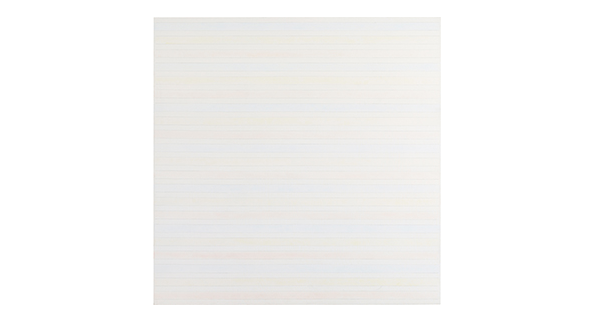At the Stanford Arts Review, we find the Andersons’ generous gift to Stanford a cause for both public and intimate celebration. We encourage you to visit the collection, force your expectations of art out the door and open yourself to discomfort. For what is modern and contemporary art, after all? Scribbles on a canvas, clean lines, exultations of color that arise in all their material glory from the human mind.
We now bring you a weekly series where our writers confront each painting and sculpture in the Anderson Collection, from 001 to 121. This week: Agnes Martin’s Untitled #21, Ellsworth Kelly’s Black Ripe, and Paul Wonner’s Figure By Window.

022. Victor Liu on Agnes Martin’s Untitled #21
Agnes Martin is an American abstract painter and integral member of the Abstract Expressionist school, most known for her subtle shifts and color and emphasis on geometry and grids. Untitled #21 is aptly named for its strict adherence to the rules that define her artistic output.
Stanford emeritus professor of American art history, Bryan J. Wolf, might say that the series of horizontal bars is meant to evoke the practice of reading. It embodies the power of storytelling, egalitarian in its accessibility and reach. In a post-structuralist, Barthesian manner, we are all empowered by reading. The piece’s saturated colors, awash in light, act as a sort of spiritual deliverance. Martin’s scripture is further activated by the piece’s monumentality and sheer size. “Reading,” says Wolf, “is grace,” cleverly re-appropriating the final line of a Michael Fried text. A fitting interpretation from someone as well read as himself.
Out of academia and into the art museum, bored and affluent Silicon Valley housewives discuss the Martin on their own system of merit. “It’s pretty, I suppose, but is it something you would buy and hang it in your living room?” The other shakes her head. The colors are too spring, and, this season, geometric minimalism has fallen out of vogue for the chicness of tortured black-and-white photography.
The grace is lost. Reading lies dormant in the very books that speak of it, known only to those who care to open them.

023. Clara Galperin on Ellsworth Kelly’s Black Ripe
Throughout our years of acquaintance, Ellsworth and I have had a conflicted relationship. Our first encounter was at the Met many years ago. I was a small child and he waltzed into view in the form of Spectrum V, a work that consists of a long row of rectangular solid-colored gradient panels. I spotted it from the corner of my eye and reacted with a visceral “!!!” in the pit of my stomach. We hit it off right away; it was all quite exciting. Unfortunately the romance did not last long. As my teenage years and their rebellious proclivities settled in, my skepticism grew and Ellsworth’s allure waned. Alas, his solid colors in geometric forms ceased to spark a true reaction within. I grew ambivalent. That is – thankfully – until I happened upon Black Ripe.
Our meeting was unexpected, and I had a lot of questions. Black Ripe? Hm. Your curves are quite delicious. Your name suggests you’re ready to bite into – do I come closer? Or should I stay here? You’re delightfully simple in form yet so surprisingly hard to read. And intimidating. And seductive, all at once! It’s your contours, perhaps? Your darkness gives me vertigo. So are you flat or what? OK, I’ll come closer. Yes, I was right about the vertigo. Why don’t you fear the edge of the canvas? I’m going to have to take a step back now…
Ah, Ellsworth. You’ve proven the cynic within me wrong. Your Black Ripe is carved in the crevices of my brain. Although no answers were disclosed, the “!!!”’s back.
